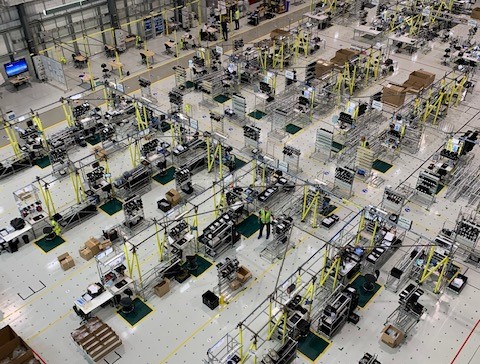
The Engineering community has been key to addressing many of the challenges thrown up by the pandemic. It must now be at the heart of our plans for a more resilient future writes Paul Taylor FREng, Director of Morgan Stanley International and Chair of the Royal Academy of Engineering’s Critical Capabilities Working Group
The Royal Academy of Engineering recently published a report, Critical capabilities: Strengthening UK resilience, which recommends steps the government should take to make the UK more resilient to new pandemics or other emergencies. One of the main recommendations is that it should embed an engineer’s ‘systems’ approach in emergency planning and preparedness with the help of both public and private organisations.

But the report also calls for all organisations across the public, private and third sector to reach out and make connections beyond their immediate and familiar communities—to review and perhaps reassess where their interdependencies lie within the wider system, and how vulnerabilities can be reduced and resilience strengthened.
The role of critical capabilities in an emergency response
As the crisis caused by the COVID-19 pandemic was evolving, individuals, teams, organisations, collaborations and projects across all technical specialities, disciplines and career stages within the UK engineering community stepped up to maintain essential services, critical supply chains and infrastructure in unprecedented circumstances, using their training and skills to find innovative solutions to a host of problems and to help mitigate the impact of COVID-19 on our daily lives. Engineering expertise and innovation has proved central to the fight to save lives and protect livelihoods not just nationally, but globally.
Engineers see emergency responses and planning as a series of interdependent and interconnected systems of capabilities
While dealing with the immediate challenges posed by the pandemic, engineers, like others, were also asking what the UK as a whole needed to do to be more resilient to address the emergencies of the future. What needs to be in place to ensure that we are better able to anticipate, resist, absorb, recover, and adapt to shocks and stresses in the system with agility, to enable continuity of delivery of critical needs?
Engineers see emergency responses and planning as a series of interdependent and interconnected systems of capabilities. An effective national response to an emergency or crisis is one that can rapidly call on the right capabilities to deliver the most effective response at the required pace. The Academy’s report describes this in terms of ‘critical capabilities’ and focuses on the actions needed to identify and build these critical capabilities ready for future emergencies.
Resilience requires cross sectoral transparency
Each emergency has a defined system boundary with the relevant capabilities that are most necessary to respond well. For most emergencies of scale, this will go far beyond the well-networked elements of the public sector and emergency services and will also need to draw on organisations, people and resources in the private and third sectors. Business and civil society are crucial to whole-society resilience.
Resilience can be mistaken for redundancy – instead, it is often a rich ecosystem which needs to be nurtured and ready to respond with agility when an emergency occurs
My experience of working in both the public and private sector in defence and security has shown me time and again how crucial practice and a shared understanding of each other’s capabilities and vulnerabilities are. Every crisis has specific characteristics and uncertainties that cannot be fully anticipated. There is a premium on understanding your system well in advance to quickly leverage the right capabilities for an effective emergency response. This requires identification and strengthening of the wider capabilities across the public, private and third sector which build greater resilience in the face of crisis; in particular, understanding what capabilities are available, how they interconnect and how to build them into the UK’s emergency response, planning and preparedness by embedding a systems approach. Resilience can be mistaken for redundancy – instead, it is often a rich ecosystem which needs to be nurtured and ready to respond with agility when an emergency occurs.
More to be done
Looking at potential future emergencies, there are challenges to building the joined-up, principled and transparent governance and leadership systems necessary from local to national levels. The UK government has made building resilience a key part of its Integrated Review and Global Britain agenda. A resilient UK is a good place to do business and now is the time to think ahead, strategically and inclusively.
The day after Critical Capabilities was published, the UK government unveiled plans for an international surveillance network aimed at identifying and tracking new Covid variants and other emerging diseases. Expected to be up and running before the end of 2021, the Global Pandemic Radar will be led jointly by the UK and the World Health Organisation in collaboration with the Wellcome Trust and other partners with the aim of saving lives and protecting health systems by spotting diseases before they cause future pandemics. It will also seek to enable the rapid development of vaccines, treatments and tests. International coordination is a crucial capability to enable effective communication and access to expert advice necessary mobilise a rapid response. It is just one piece of the resilience puzzle. I strongly hope that a wider systems view will be applied and a broader consideration of all critical capabilities will support building a whole-society approach to resilience, without which we risk missing the mark.











Water Sector Talent Exodus Could Cripple The Sector
Maybe if things are essential for the running of a country and we want to pay a fair price we should be running these utilities on a not for profit...